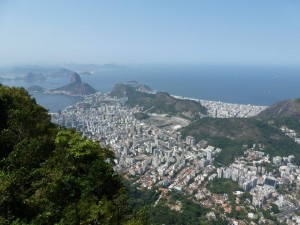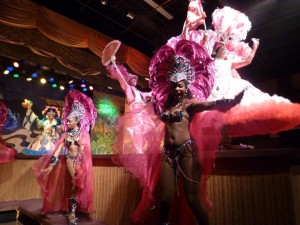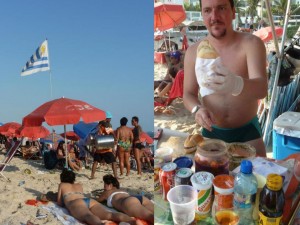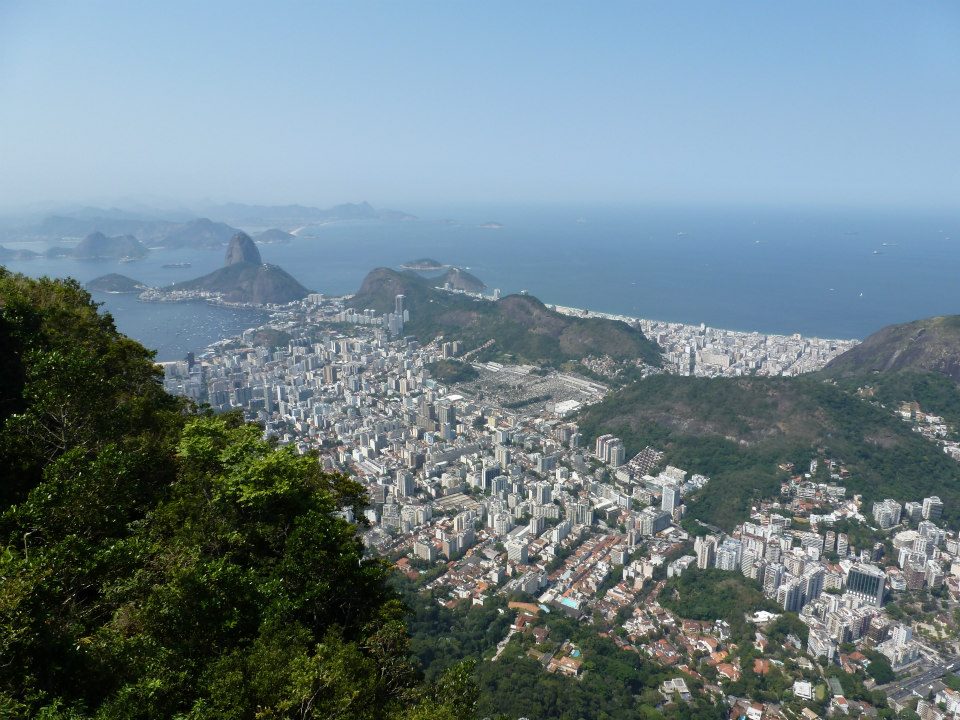
Rio de Janeiro quickly became one of our favorite travel destinations in the world during our time in Brazil. While São Paulo holds the bulk of Brazilian jobs and money, almost everyone you meet in Brazil will tell you that if they could truly live anywhere, they would choose Rio.
Our Favorite Places

Beaches
With most Brazilian families heading to the beach on weekends whenever possible, sometimes as much as three to four times a month even for a family living in a city a few hours away, beaches mean as much to Brazilian culture as teatime in England or football tailgates parties in the American South, and Rio could easily be labeled the capitol of this culture. Many “Cariocas,” as Rio locals are deemed, spend the bulk of their time in two places: the gym and the beach. Anyone arriving with an American-bought swimsuit will quickly notice that they are overdressed amongst the Cariocas, often some of the world’s most beautiful people, donning sungas and Brazilian bikinis with a pair of Havaianas.
Ipanema and Copacabana are the primary beaches and were immortalized long ago by pop-culture references. They are divided by the Arpaodor Rock, a popular nighttime destination. Locals use post markers, near the street and usually housing lifeguards, as meeting point references. The post numbers have also come to define which type of people generally meet in the vicinity.

Favela Tour
Prime real estate in Rio overlooking the beaches from mountains and hilltops above is not auctioned to the highest bidder but instead actually is home to some of Brazil’s most notorious favelas. We toured Rocinha, the largest favela in South America. Upon arriving at the bottom of the hill, our tour guide paid for each of us to take a mototaxi to the top. He was able to find mototaxi drivers willing to accommodate the female members of our group much more quickly than he was able to find drivers for the men. In the favela, rent can sometimes be higher than you would expect; however, citizens have no other bills. Electricity is tapped off of the grid in a sloppy disorganized fashion reminiscent of Old Delhi in India. Other services, including water and television, are also branched into the favela through the work of handymen. Armed guards stand along entrance ways and cannot be photographed. With the World Cup and Olympics both coming to Brazil, police have worked to clean up favelas, and they are now deemed as safer than they once were. However, they remain policed much more by elected residents than by city police. Many of these favela leaders have actually recently outlawed crack in their communities, citing the damage it has done to addicts.
Word of warning – be sure to do a tour with a legit guide through a favela. Traveling alone through such an area can be very risky.

Dance Performances
Since we are unable to attend Carnavale this year due to our upcoming move to Switzerland, we found two places where locals advised us we could see the closest show to Carnavale without being there. First, we attended a Platforma show at the Flamengo Theater, held mostly for tourists but it remains the best show of its kind that we have witnessed in Brazil. Showing the history of dance in Brazil, men and women in full costume perform while tourists eat and drink.
On our next trip to Rio, we spent a night at the Salguerio Samba School. Crowded with people throughout the night who told us that they were born dancing the samba and that is why they dance it so well, Salguerio was a constant show of drums and dancers on a warm Brazilian night with caipirinhas pouring to cool down. Salguerio Samba Queen Vviane Aruajuo, a local celebrity, was also on hand to lead the band and wave to her awing admirers.

Lapa
Once you have attended each of these events, you’re fully ready to explore the famed samba neighborhood of Lapa. However, don’t miss out on a daytime neighborhood to this nightspot as well or you will miss Escadaria Selarón, a continually evolving staircase of artwork by Chilean-born artist Jorge Selarón who often included his own likeness as a pregnant woman in his artwork and began with tiles collected from his world travels as a tribute to Brazil.
In a tragic turn of events, Selarón was found dead yesterday on his beloved masterpiece. His death is being felt globally as Rio and the world loses such a talented and dedicated artist. It’s too early to tell what will happen to Escadaria Selarón, but it would be a shame to see the staircase not kept up in memory of its creator.

Cristo Redentor
Of course, you are not done exploring Rio until you have visited Cristo Redentor (Christ the Redeemer). The climb to the top of the hill can take ages on foot or by car but a tram (for a fee) also runs to the top if you find yourself at the base of the mountain. Just as with the Eiffel Tower, Taj Mahal and other major world tourist attractions, the site is a memorable must-see but you will spend the majority of the day waiting to get inside. Once you have climbed the mountain, you will find the ticket line, purchase tickets and pay for the honor of joining another queue leading to the bus. A bus will take you farther up the mountain to the base of Cristo where you wait it another line before being allowed inside the gate where you still face a bit of a walk upward and more crowds. Whichever day you decide to visit Cristo, go as early as possible. Lines are shorter in the morning and the view is also less likely to be obstructed by thick fog. Other acquaintances have shown us pictures that they took in the late afternoon from above Rio in which the scenery is nothing more than a white cloud.

Pão de Açúcar Mountain
Another great view of the area comes from Pão de Açúcar (Sugarloaf) Mountain. We arrived on the 100th birthday of the bodinho (cable car). Although you will be unable to enjoy the festivities and cake available on this special day, the views as you rise to the top of the mountain, over those climbing the mountain by more strenuous means, are spectacular.
Parque Lage
If you have time, one more spectacular view seen around the world thanks to Snoop Dogg and Pharrell is in Parque Lage, a park complete with monkeys surrounding a 1920s mansion near the Botanic Gardens and at the base of the Corcovado looking up at Cristo.

Eats
We followed our favorite travel advisor, Anthony Bourdain, on his recommendation to Barraca do Uruguay, a Uruguayan grilled pork sandwich stand easily identified by the blue and white Uruguayan flag at Stand #80 in Ipanema. Churrascarias, offering endless meats brought to your table awaiting the response of a nod for yes or finger wave for no, are popular throughout Brazil but some of the most revered hail from the Rio area. For a truly Brazilian night, the visitor must devour an endless amount of meat followed by caipirinhas of domestic Cachaça and drank while either watching or dancing the samba. Americans beware, however, of the rare all-you-can-eat opportunity in Brazil. As pay-per-kilo buffets are much more common, you can actually be fined for taking too much food and leaving it on your plate.
Working in Rio de Janeiro
So what is Rio like for the resident who sees some of the most beautiful sites in the world on a daily basis? Although Leo Nguyen has lived in other cities around Brazil, he confirms what others who dream of working here always suspect, the sites never get old and “Rio tops it all.” Like most Cariocas, Leo does not talk much about work; that is not what defines him. Instead, he describes a lifestyle and culture much unlike the gridlocked traffic jam of businessmen in São Paulo that allows him to train five times a week in his favorite activities of Jui Jitsu and Muay Thaim while working downtown. After his heavy workout, he generally meets friends for drinks and to socialize near the beaches.

“The beauty of the Carioca vibe is that the passion to enjoy life is there, to enjoy that moment and not get caught in later or tomorrow. It’s living in the now and being here. Living here or just visiting you feel that energy and it’s liberating. Very out of the box from the U.S. stand point.” says Leo. “People smiling and laughing and enjoying life. Brazilians will never run dry on passion and it’s infectious.”
That lifestyle only intensifies on the weekends as heavy traffic brings in Brazilians from all cities and the night becomes even later, starting later and finishing later. Bars never close until the sun is up.
We give Rio a 9 on our list of favorite places to be. Where is your favorite beach?
-Chris & Monica


Hi! It’s so sad you guys already left Brazil and we didn’t get to know you two! Just one curiosity that maybe nobody has told you. Cariocas are usually known as people that like to take advantage of the others (we say they are “malandros”), maybe because of how their accent sounds to us. It’s not that we don’t like them, but it’s a joke that specially paulistas (people from São Paulo) usually tell about them. Actually, paulistas and cariocas always compete against each other with silly things like “which is the best and most important city in the country” or “who has the better accent” and even “which city is safer” (cariocas are usually afraid of walking on the streets of São Paulo and paulistas, the contrary).